- Author Matthew Elmers [email protected].
- Public 2023-12-16 21:49.
- Last modified 2025-01-24 09:17.
I'm like a broken toy forgotten on the shelf …
Alice Cooper
Once upon a time, Tsar Peter III walked here … The life of each of us never stands still. We are constantly striving for something, losing something, often changing positions and professions. Our hobbies also change with age, as well as the objects that surround us. Growing up, we put toys in the closet, after learning, we put textbooks and books of the classics on the shelf so that we can hardly return to them without great need and desire. Household items, clothes, cars are changing, but what can I say, even the people of our environment sometimes replace one another! Many people remember that when personal relationships come to an end, you suddenly feel like a broken toy, forgotten in a closet … Well, buildings and structures abandoned by people are also falling into decay - all of us have seen photographs of the ghost town of Pripyat or photographs of the ruins of gold mining cities somewhere in the American Wild West. And now we will talk about one abandoned place - a fortress in which drums once thundered, gunpowder salvos rumbled next to it, and life was in full swing in the fortress itself!
Oranienbaum and Petr Fedorovich. How it all began
St. Petersburg is a large city, it is spread not only at the mouth of the Neva River, but also covers both coasts of the Gulf of Finland like wings. Pushkin, Pavlovsk, Zelenogorsk, Lomonosov, Petrodvorets, Kolpino, even the fortified city of Kronstadt, located on Kotlin Island in the middle of the bay - all these cities are also part of St. Petersburg. The most important "pearl" of the city of Lomonosov is the Oranienbaum palace and park ensemble, which was founded at the beginning of the 18th century; then this land belonged to Alexander Danilovich Menshikov. It includes a park with the Karastaya River and several ponds, the Grand Palace with the Lower Garden, a number of smaller buildings - the Chinese Palace, the Katalnaya Gorka Pavilion, the Cavalry Corps and other and other attractions.
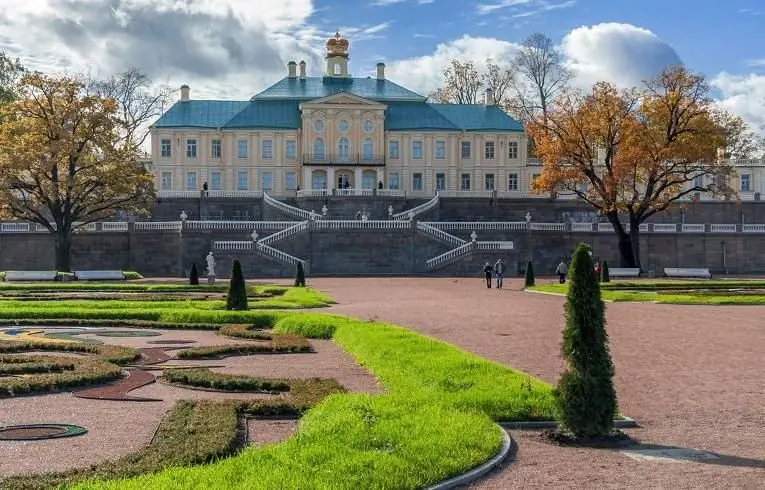
This is how the central part of the Bolshoi, or Menshikovsky, Palace in Oranienbaum looks like, if you look at it from the Lower Garden. Unfortunately, the history of this building is not included in the article, but how can you not look at it! The palace was built in 1711-1727, its architects were Giovanni Maria Fontana, Johann Friedrich Braunstein, Gottfried Johann Schedel. By the way, Fontana and Schedel also designed another Menshikov palace - in fact, Menshikovsky, which is on Vasilievsky Island. The picture is beautiful, a professional worked. Now the facade of the palace is being renovated, and is partially covered by building structures.
The park with its beautiful buildings is a real find for everyone, because you can walk with a leisurely conversation until closing time. I must say that the territory of Oranienbaum is now developing, and it is only getting better. But in winter, lovers of skiing come here, the only thing they will not be able to admire the figures installed here - for the winter the statues are covered with special boxes. The memorial sign in honor of A. D. Menshikov, a sculpted orange tree, in honor of which the area got its name.
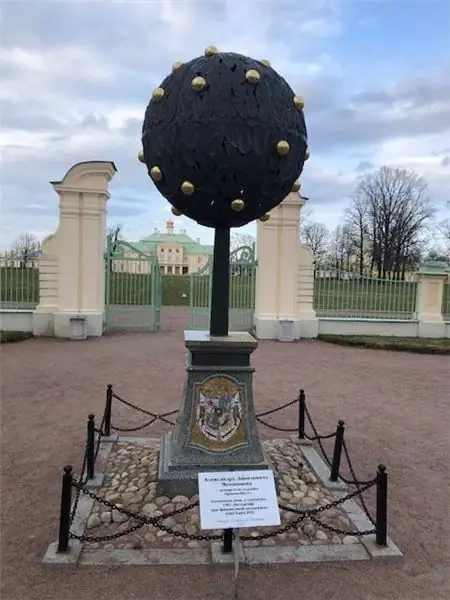
Orange tree. Monument to Alexander Danilovich Menshikov - the founder of the Oranienbaum estate. An orange tree with gilded fruits forged from iron and bronze is installed on the opposite side of the Grand Palace. It stands on a marble pedestal and is decorated with Menshikov's coat of arms. Authors: T. Laska, S. Golubkov.2011.
His Serene Highness Prince Menshikov, the first owner of these places, as we remember, found himself in disgrace in 1727, and then was completely exiled to Siberia with his whole family. Time passed, and in 1743, Oranienbaum was granted to Grand Duke Peter Fedorovich, the future Emperor Peter III. One can argue endlessly about this man and his role in the history of Russia, someone draws him as a complete degenerate, others as an incomprehensible genius, but we will try to unbiasedly review his contribution to the history of Russia on the example of the … fortress he built. Namely, the Petershtadt fortress.

From childhood, Peter felt a craving for military service, at least for its "outer side" - formation, guard, marching, parades. Upon his arrival in Russia in 1742, Jacob Shtelin, a member of the St. Petersburg Academy of Sciences, became one of his teachers. He conducted activities with the heir, more reminiscent of a game, read books with pictures containing images of fortresses and siege weapons with the future emperor, they studied their models together, so it is not surprising that fortification and artillery became the favorite subjects of the heir. Peter's abilities were highly praised by Stehlin, who drew and drew with him. The plan of the Yekaterinburg fortress, made, perhaps, by Peter himself, and the drawing of the fortress bastion in three projections, made by the hand of his teacher, have been preserved. This amusing fortress for the entertainment of the Tsarevich was built in 1746 south of the Great Palace in Oranienbaum; it was miniature, about four bastions, and was named in honor of the grand duke's wife, Ekaterina Alekseevna, the future Empress Catherine II. Inside the fortress there are three wooden buildings: the Commandant's house, two guardhouses - an officer's and a sailor's; three drawbridges were built across the moat. The fortress itself has not survived!
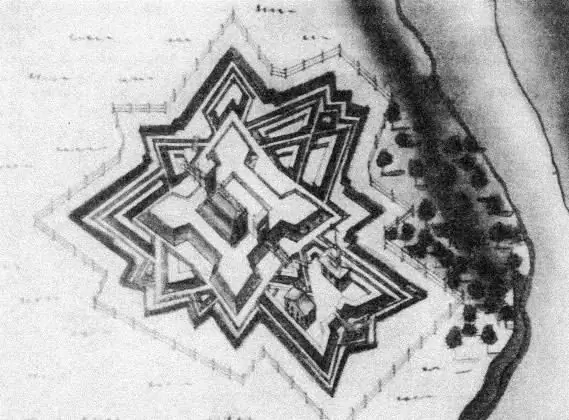
It is here that Peter forms his first company from the courtiers, and appoints himself as its captain. The company marching and shooting all day. Count Golovin becomes the commandant of the fortress; his wife, Ekaterina, orders five barrels of one-pound cannons for Peter with his monogram - PF, as a gift, these cannons were made in the St. Petersburg arsenal. But the young wife clearly misses such activities, Empress Elizabeth is also unhappy with this "game of soldiers" …
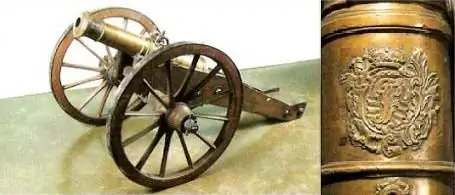
New fortress. No, give me two
But the "most interesting" thing in Oranienbaum park began to happen when Holstein troops arrived to Peter in 1755 - the Grand Duke regiment and the Grand Duchess (Duchess) regiment. The heir is simply overjoyed, lives in a soldier's camp and devotes his days to military studies. In the same year, 1755, the Holsteins were sent back to their homeland, but the next year they were returned to Russia at the insistence of Peter. Among the "toys" of the Grand Duke, not only new "soldiers" appear, but also new buildings - at the confluence of the Karasta river (sources say "Karost") into the Lower pond of the Oranienbaum park, on the high right bank of this river, on May 23, 1756 new fortress!
The work was contracted by Samson Bobylev, the coachman of the “Novgorodsky district, Tesovsky pit”. All conditions, including the size of the fortress and the fact that the contractor promised to keep at least fifty people at work, were negotiated in the contract, as well as the amount - 750 rubles. The settlement with Bobylev was made "at the end of that work" back in September 1756, but the construction was fully completed only in 1757. The new five-bastion fortress of St. Peter was slightly larger than the Yekaterinburg fortress. The fortress was densely built up - through the stone Honorary Gate one could get to the Arsenalny Dvor, on which the half-timbered Commandant's house, the wooden buildings of the arsenal, "kofishenskaya", a tavern (where without it!) And the house of chamberlain LA were located. Naryshkina. The date of completion of construction - 1757 - is carved on the metal weather vane of the Honorable Gate. Peter himself was the commandant of the fortress.
Appetite comes with eating
The new fortress has just been completed, but the heir wants more! In May 1759, he ordered to increase it, and for this he released a whole thousand rubles. The built ramparts were torn down, and in their place the township head of Olonets Fyodor Karpov and the peasant Agafon Semyonov are building new buildings - two buildings of the Arsenal, cut down "in the paw", and on both sides of the Gate of Honor - the "Shotgun Chamber" and "communications for the position of tents and other military luggage ". The reconstructed-enlarged fortress now receives the sonorous name of Petershtadt. The peasants Dmitry Golovka and Vasily Zotnikov are building the "stone house", or the palace of Peter III, under the guidance of the stone craftsman Eric Gampus, designed by the architect Rinaldi. The documents of the engineer-lieutenant Savely Sokolov have survived, who requires two hundred excavators, twenty sod-layers and fifty masons for the construction of two stone casemates, the contract for them was signed in March 1761, these casemates are considered the last fortress structures of Petershtadt. On April 18, 1762, Peter III ordered "to repair the help to the structure of the fortress", a month later the sergeant-major Alexei Fomin draws up the first inventory of Petershtadt, and, finally, two days before the coup that led to the deposition of the unlucky emperor, on June 26, 1762, the last thirty cubic fathoms of turf were laid at the counter-escarp wall and on the parapet. The fortress itself was a 14-pointed "star" in its plan.
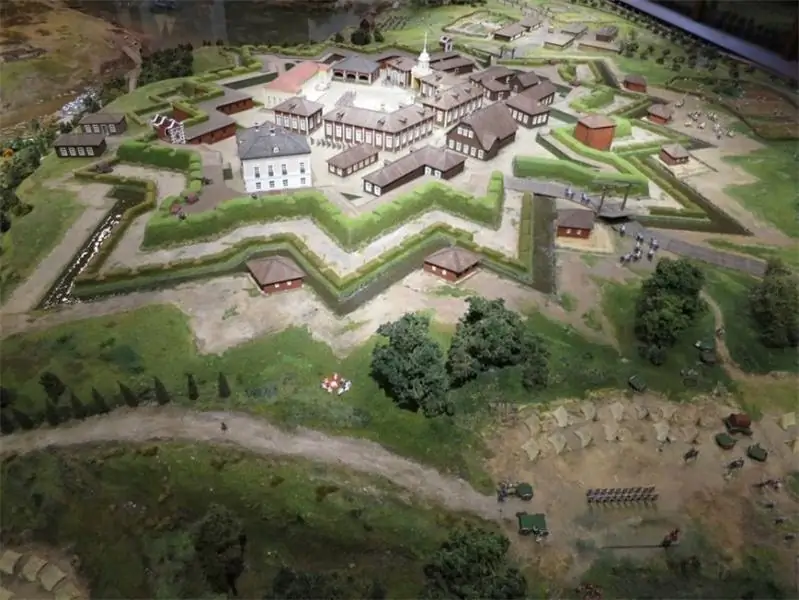
There are disagreements about who was the author of the new fortress. But academician Jacob Shtelin says that the project was made by a certain engineer-captain Dodonov. Most likely, this refers to Mikhail Alekseevich Dedenev (1720-1786), a Russian engineer who is responsible for the design of both military and civilian structures; it can also be said that the principles of fortification invented by him were ahead of his time. That is, he was truly outstanding as a fortifier!
Petershtadt: fortress, fleet, entertainment
The garrison of Petershtadt consisted of Holsteins, Ukrainian Cossacks (sic!) And, of course, Russian soldiers too. The main part of the troops was based in a military town outside the fortress. In the town there were artillery, cavalry (for dragoons, cuirassiers and hussars) barracks, stables, an infirmary "for Golstein servants", and there was also a shooting range with a "machine on which a bird made in summer is shot" - that is, a moving target !
The fortress was built according to all the rules of military science, applicable to this place. From the north it was covered by a pond, from the east - a ravine, from the west - a river (and the bank is quite steep there!), And only from the south the area was a plain, and it was this section of the fortress that was especially fortified - not only an additional earthen rampart was built there (fossebreya, false embankment), but also two ravelins. The moat around the fortress was a fathom deep and two fathoms wide, the main shaft reaching a height of two fathoms. On the inside, a wide embankment (valgan) adjoined the rampart; it was along it along ramps - gentle slopes, guns were rolled onto the bastions. Also on the southern front, at the bottom of the ditch, four stone booths were set up - a caponier, from which this ditch could be shot from guns. For the imperceptible accumulation of infantry before the attack, an artificial lowering of the terrain was arranged around the entire fortress - a "sheltered path".
The northern front of the fortress, facing the Lower Pond of Oranienbaum, was specially arranged, and this is why: under Peter Fedorovich, the pond itself was proudly called the "pleasure sea", the vastness of which was plowed by a whole fleet! Presumably, his first ship was the eighteen-gun frigate Saint Andrew. Later, in 1756, it was joined by the 12-oared galley "Ekaterina", two years later - by the galley "Elizabeth" (twenty-four oars). The galleys were armed with two half-pound cannons each, in addition to which were also fitted with falconets. Less is known about another flotilla pennant - the ship Oranienbaum. Its armament is attributed to 12 to 20 one-pound cannons, and it is possible that his tenure in the amusing fleet was very short. Confused only one thing - the depth of the pond rarely reached three meters. Therefore, all ships were reduced copies of warships, the length of the "St. Andrew" between the perpendiculars was 11.3 m, and the draft of 1.2 m, the "Ekaterina" and "Elizaveta" had a draft of 0, 6 and 0.8 m, respectively. But these ships were made in compliance with all the proportions of real warships, and their decoration was luxurious - for example, the nose of the frigate "St. Andrew" was decorated with the figure of the goddess Minerva in armor, with a shield, spear and helmet. Sergeant Elin was in charge of the sim fleet until its destruction.
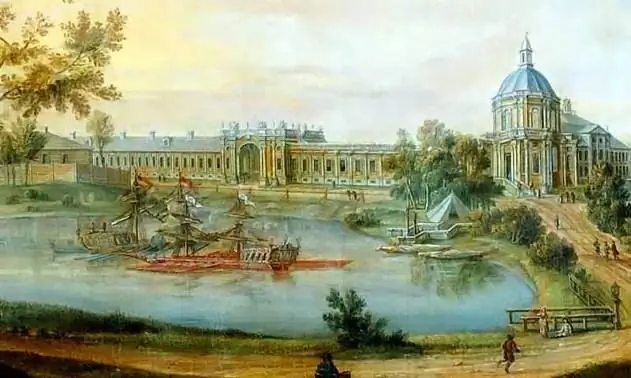
From the north, Petershtadt seems to have been designed for a duel with naval artillery, and adapted for antiamphibious defense. On the steep slope of the bank of the pond, a retrenchment was made, and the curtains of the fortress in this place were stone casemates with embrasures for cannons, and not earthen ramparts. It must be said that all the artillery of the fortress consisted of 12 cannons and 250 "hasty tubes", and all the guns were on the northern, "sea" front (according to archaeologist and historian VA Korentsvit).
The fortress was about four bastions, but the Arsenal yard, being in the center, was pentagonal. This happened as a result of the fact that initially he repeated the outlines of the previously built fortress of St. Peter, and, as they say, “inherited” the new fortification. There were three entrances in Petershtadt, and only one of them was fortified according to the rules of fortification (the other two, rather, were temporary, during the construction of the fortress). As many as seventeen buildings were located inside the cramped inner space of the fortress. Who was their author is unknown - except for the palace of Peter III, built in 1759, the architect of which was A. Rinaldi. Perhaps the rest, rather modest wooden buildings, were built by Martin Hoffmann. Of these buildings, it is worth listing the Commandant's House, the Guardhouse, the Zeikhhaus, the houses of Generals Leuven and Fersten, the arsenal buildings. A Lutheran church was also built, which is understandable given the religion of the Holstein soldiers. On June 23, 1762, the solemn consecration of this church was held, and the emperor himself, his entourage were present, and on that day there were firing from guns and a three-time volley from the garrison during the prayer service.
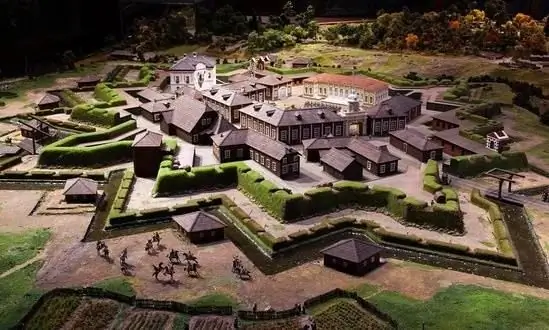
And what should the heir, and then the emperor, do when he does not hold military games or parades? Of course, relax with pleasant conversation and a glass of coffee! For the entertainment of Petra, a whole amusement garden was arranged in the Karosti Valley. As already mentioned, houses were built in this garden - the Hermitage, the Chinese pavilion, the Menagerie (menagerie). In the center of the Menagerie and near the Chinese pavilion, fountains were arranged in the summer of 1760. Also on the eastern bank of the Karosti, a cascade was arranged, decorated according to the principle of "expensive-rich": there were fifteen mascarons and two dragon statues, and the mascarons and dragons still needed to be gilded, and for this, in May 1762, leaf gold was even released ! Sounds of pouring water, birdsong, laughter of beautiful ladies, a glass of tart wine and a fragrant pipe in hand - what else is needed for a good rest? In this case, we will perfectly understand the king, because practically nothing has changed over the centuries! We, too, prefer barbecue outdoors … although the tsar's servants, most likely, better cleaned up the garbage after their monarch than some of us now do, having plenty of "fun in the open air"!
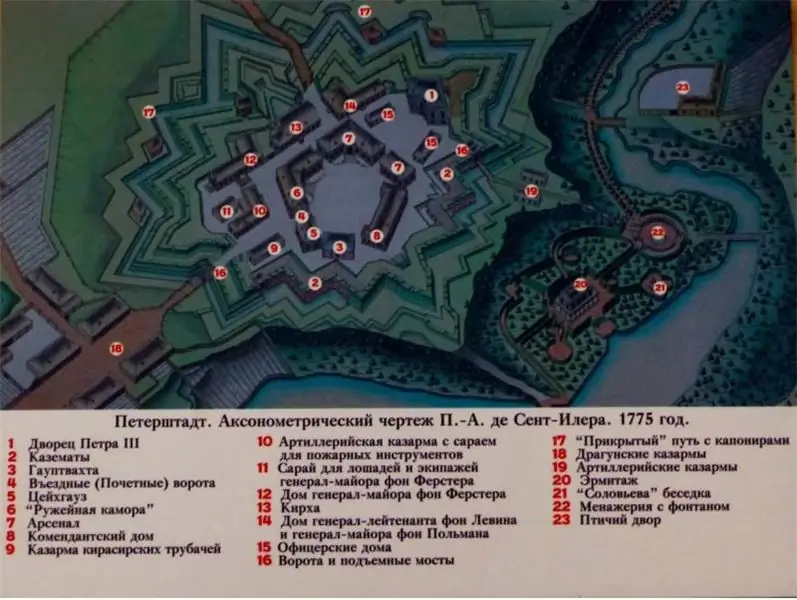
The king and his personal army
Here, in Oranienbaum, Peter is happy … For example, if earlier he did not tolerate tobacco, now he puffs with might and main like a steam locomotive that has not yet been invented, and his society is usually made up of Holsteins, with whom he conducts his reviews and teachings. Again, how much does a person need to be happy? Yes, nothing at all - an army of "soldiers" and its own amusing fortress! (By the way, the son of Peter III, Pavel Petrovich, went even further - he had both the Mariental castle and the Mikhailovsky castle, and then Gatchina looked more like a military camp). In this regard, it is worth saying little about this personal Peter's army, although this topic requires a separate article. In the Holstein army of Peter, each regiment bore the name of its chief, had its own differences in uniforms and foreheads of grenadier hats. By June 1762, infantry regiments were located in Oranienbaum: Prince August's regiment (musketeer and grenadier companies), Puttkamera (musketeer and grenadier companies), Ferstena (1st and 5th musketeer companies), Zeimerna (grenadier company) Wilhelm (grenadier and four musketeer companies commanded by Colonel von Olitz). Other units included: Olderog's artillery detachment, cuirassier regiments of Leuven and Schildt, hussar regiments of Zobeltitz and Kiel. The most beloved military unit by Peter was the Leib-Dragoon regiment …
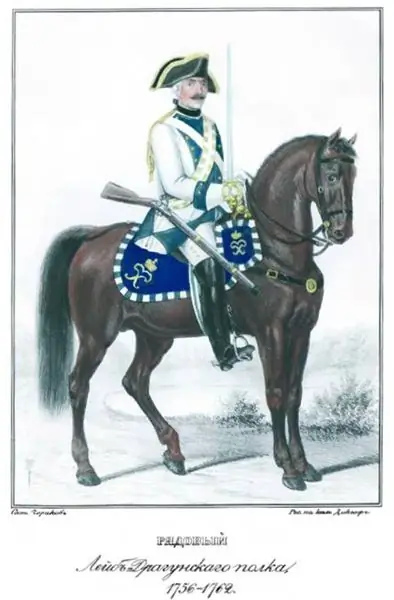
All in all, Peter's "personal army" numbered about 2,500 people. The regiments had their own musicians - oboists, flutists, drummers. To the music, the Holsteins march cheerfully and clearly no worse than the best Prussian guards, than shock Field Marshal Minich: “This is true news for me; I have never been able to achieve this. " By the way, the marches of Frederick II, the recent enemy of Russia, now the tsar's idol, are often heard … Peter himself is present at the parade every noon. The basis of the fortress arsenal, according to Shtelin, was "the excellent armory of the former chief-marshal of the Count Brummer, which was bought by the empress and presented to the Grand Duke" (apparently, Elizabeth bought it if Peter is listed as the Grand Duke). The lower pond of Oranienbaum with the amusing flotilla lined up on it is called the "pleasure sea".
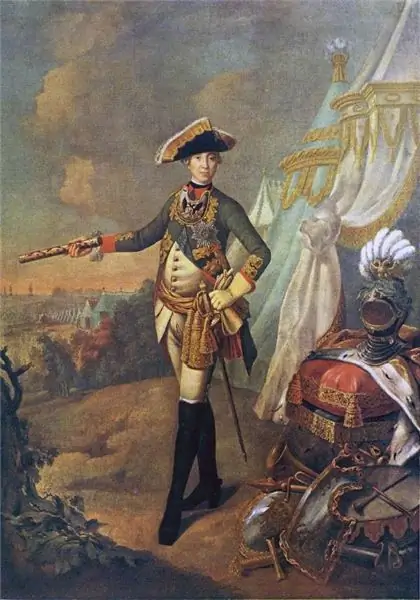
With things on the way out! The games are over …
Having ascended the throne, Peter developed a vigorous activity - during 186 days of his reign, 220 personal decrees and 192 documents were issued. But, as we know, not everyone liked the tsar's ideas. And his behavior is liked by even fewer courtiers and, especially, the Russian guard. A conspiracy is brewing, and on June 28, 1762, Tsarina Catherine goes from Peterhof to St. Petersburg, where the Preobrazhensky and Izmailovsky regiments swear allegiance to her. In the greatest delight from the coup is the Horse Guards regiment, which hates the uncle of the emperor, Prince George-Ludwig Holstein, his boss! And in Oranienbaum, no one knows anything about this, and, as usual, in the morning Peter III is at the divorce of his Holstein regiments - the regiments of Foerster, Zeimern and Prince Augustus. Then he goes to Peterhof, and there he learns about the escape of Catherine. Sent by Peter to Petersburg A. I. Shuvalov and N. Yu. Trubetskoy is not returned, but swear allegiance to the new empress, while Mikhail Vorontsov refuses to swear allegiance to her, and is placed under house arrest.
The Russian guard goes to Peterhof. With horror, Peter realizes that, although his Holsteins march excellently, only 800 people have weapons in front of the 14,000 Russian army. In despair, the emperor sails to Kronstadt, but there he is already aware of what is happening - the muzzles of loaded cannons are looking into the loopholes of forts and harbors, and the unfortunate king is shouted to get the hell out of here. Peter returns to Oranienbaum … His Holstein soldiers, it seems, were ready to fight, but the tsar dismisses them in the barracks; himself, broken, he first lay down to rest in the palace in the fortress, and then went to the Japanese hall of the Grand Palace. I spent the night there. And the next morning, Grigory Orlov and Mikhail Izmailov showed up there, who are seeking the abdication of Peter from the throne (Izmailov, Peter's favorite, will immediately receive the Order of St. Alexander Nevsky from Catherine for his "betrayal"). Power support is provided by a regiment of hussars under the command of Vasily Ivanovich Suvorov (his son, Alexander, will become a great Russian commander). Holstein soldiers are locked up in Petershtadt, their swords have been taken from their officers. The daddy of the future generalissimo, according to Shtelin, is a "monster" Suvorov, behaves extremely rudely with the Germans, and, getting into a rage, even shouts - "Chop the Prussians!"; however, this order was not carried out. The end of the story is clear - Peter was sent to Ropsha, where he died under very mysterious circumstances - which is not surprising, because, as history shows, former emperors, as a rule, for some reason do not live long … The end of his personal army was even sadder … Cossacks and Russians from the troops of Petershtadt were sworn in to the new ruler. The 1780 Holsteins, led by General Schildt, were put on five dilapidated transports and sent home. Shtelin reports that a terrible storm broke out near Revel (present-day Tallinn), the ships sank, and of those who were on them, no more than 30-50 people were saved …
Subsequent history of Petershtadt
If we add up all the events associated with the construction of Petershtadt, it turns out that Peter managed to build the fortress, but he didn’t have enough time to exercise, play with it enough! It's like getting a beautiful new toy, but losing it before you even get it out of the box. It's a shame … What happened next? First, Catherine II, in a decree of 1763, commands that the fortress should be "the best cleanliness", and in 1779 a major overhaul was even carried out here. The amusing fortress is often shown to foreign guests. In 1784, Oranienbaum Sloboda received the status of a county town, and local government was located on the territory of Petershtadt - the county treasury and the county town hall. But in the building of the church, a tapestry factory is comfortably located - and this did not shock anyone, fortunately, for the Lutherans outside, a new, stone, church was built. But in the late 1780s, Petershtadt fell into decay. And on the plans of the 1790s on the plans of Oranienbaum there is no longer the first amusing fortress, Yekaterinburg, and Petershtadt is depicted without earthen ramparts.
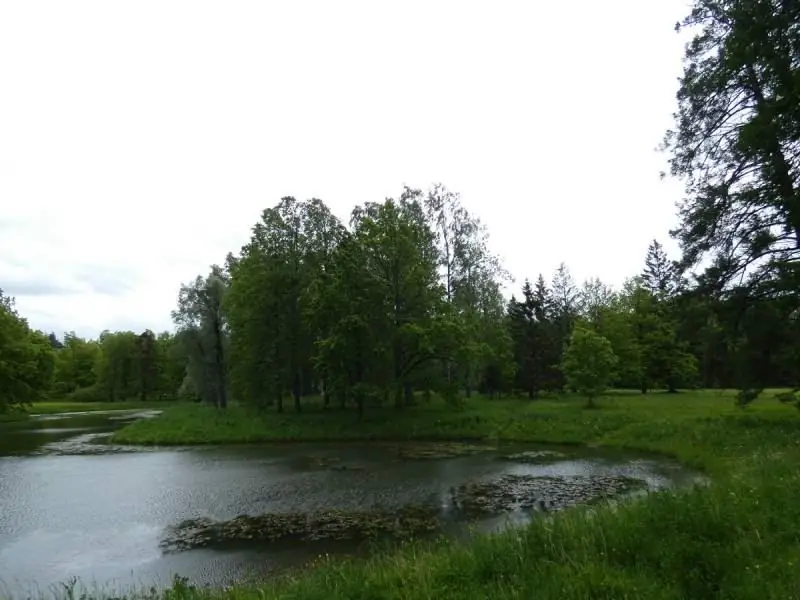
I must say that the archives for Petershtadt are quite rich. The first inventory, as already mentioned, was made by Alexei Fomin in 1762, and the next detailed inventory was made in 1784 by the architect I. Fock. In 1792, an order came to transfer things from Petershtadt's arsenal to the cellars arranged under Katalnaya Gorka - another structure of Oranienbaum, and in the same year an illiterate (according to V. A., it lists windows, stoves, fireplaces, doors, etc., right down to broken glass! Sovereign Paul I, having ascended the throne, stopped the destruction of the fortress. He gave Oranienbaum to the heir to Alexander, the future Alexander I, the same one orders "in connection with the repair and repairs of the Petershtadt fortress" to sell the dilapidated wooden buildings for demolition to the townsfolk. The auction was held in 1798, and the old buildings went to the "free innkeeper Kruten" for 150 rubles. The commandant's house is not mentioned here, but, probably, soon it was also demolished.
Only stone buildings remained: the Guardhouse, the Honorary Gate and the Palace of Peter III. The guardhouse, according to the inventory of 1792, was adapted for the kitchen, and was dismantled after 1847 (its image is in the magazine "Illustration" for that year on an engraving with a view of Petershtadt). In the second half of the 19th century, Grand Duchess Elena Pavlovna became the owner of Oranienbaum, and she tried to protect the remains of the fortress as romantic ruins in a landscape park. The ramparts were renovated, the ditches were cleaned, and in 1854 the garden inspector L. Meinike “continued work on the restoration of the rampart”.
But in the Soviet period, the former palace of Peter III was leased to various organizations. In 1940, they wanted to open a museum in it, but the war prevented. I would like to say - in fact, we were very lucky in the historical part in that the Germans simply “did not reach this place”! The power of the forts, the fire of the Baltic Fleet ships, the resilience of the defenders - this is what prevented the Germans from seizing Oranienbaum, and the Oranienbaum bridgehead was created, which existed for two and a half years. Therefore, if in other suburbs of Leningrad-Petersburg the Nazis left ruins from the palaces (they even destroyed the Rapti estate near Luga, "Luga Versailles"), blew up the Monument "Millennium of Russia" in Novgorod, and the Amber Room was generally dragged away in an unknown direction, then Oranienbaum remained relatively intact. It was from here, from the Oranienbaum bridgehead, cutting off and encircling the Peterhof-Strelninsky group of assassins in the form of a fieldgrau uniform, that the revived Second Shock Army struck at the beginning of 1944 in an operation that finally lifted the blockade of Leningrad …
After the war, in 1953-1956, new roads were laid in Petershtadt, vegetation was planted, a sculpture was placed, and the ramparts were torn down. In 1955, a museum was opened in the palace of Peter III. In the 1980s, archaeological excavations were carried out here, revealing that the fortress parade ground was paved with cobblestones. The boundaries of the parade ground were determined, and the foundations of the buildings were found.
Walk through the former fortress
But, in general, all that remains of the fortress is Peter's palace and the Honorary Gate! In a number of places we can see the remains of ramparts and a ditch. Well, if you come to Oranienbaum park, you should go here, to the southeastern part of the park, walk across the bridge over Karasta … and just relax with your soul - nature is too beautiful! It is good here both in winter and in summer.
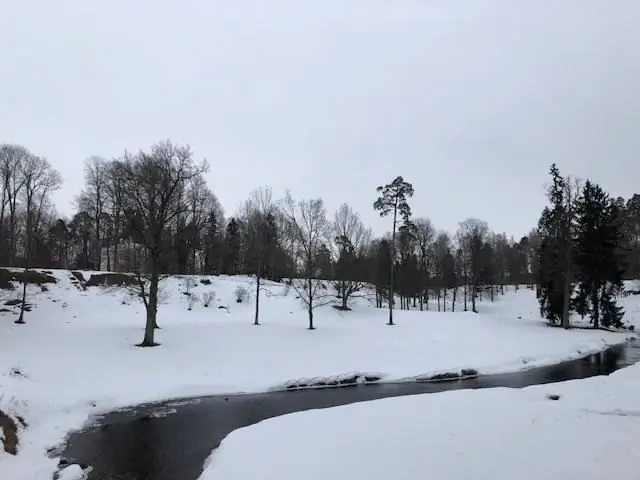
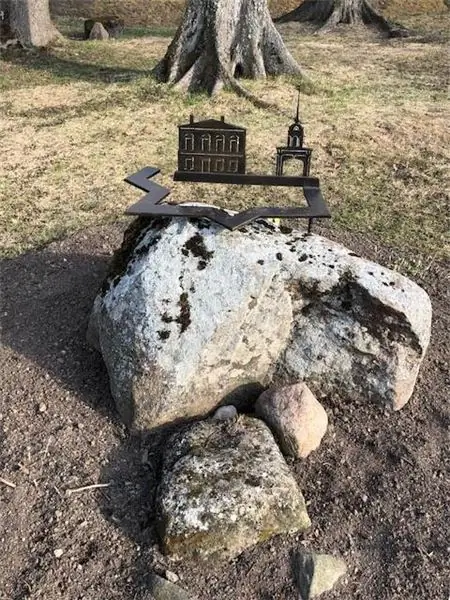
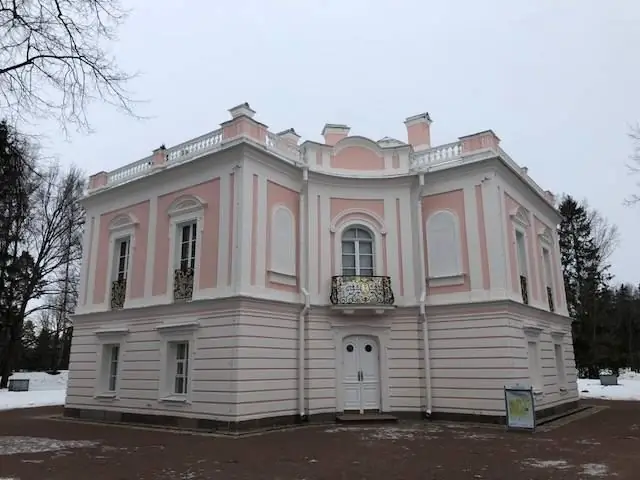
Palace of Peter III, architect Antonio Rinaldi. The Rococo style in Russia is generally inextricably linked with this architect, and a number of his buildings are located in Oranienbaum. Now the palace is a museum, but it is closed during the cold season, as well as on rainy days. By the way, Rinaldi worked not only in St. Petersburg and the surrounding suburbs. It is worth mentioning the Catherine's Cathedral, built by him directly opposite the ruins of the Yam fortress (this is the modern city of Kingisepp).
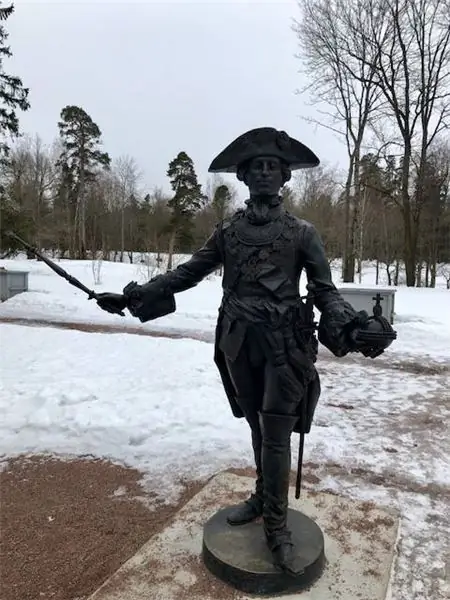
If you go from the palace to the south, you can see the remains of ramparts and ditches, on both sides of the footpath. There is a park all around, and red-haired extortionists - squirrels - are jumping in the trees!
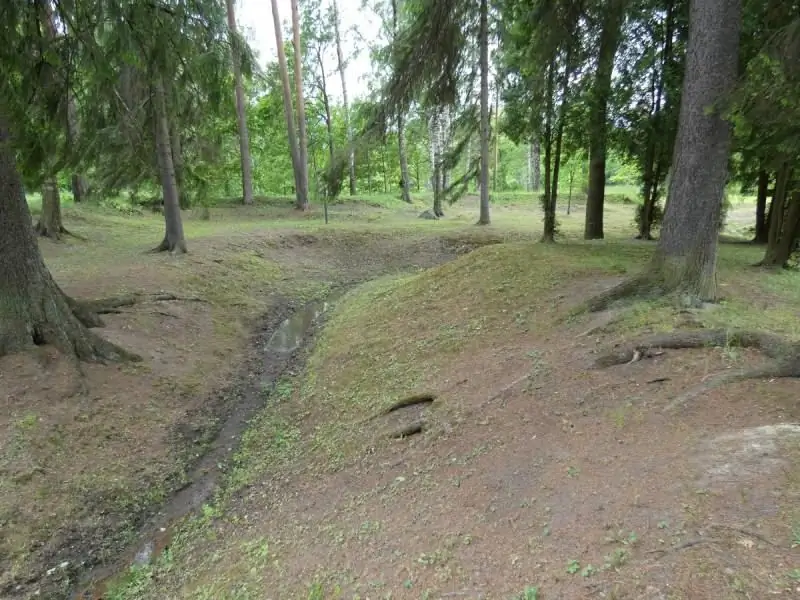
At first glance it may seem that this is just a ditch. But pay attention - it goes in such a way that the bends replace one another. These are the remains of a ditch and a rampart. A couple of minutes after this shot, another lively squirrel appeared on the tree on the right, but the author did not reshoot.
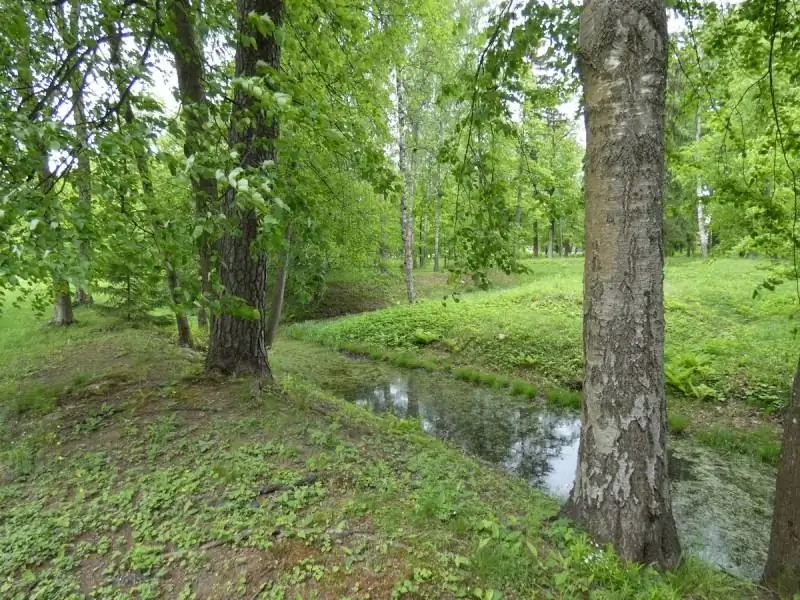
Walking back to the bank of the Lower Pond, to the north, we will see the Honorable Gate.
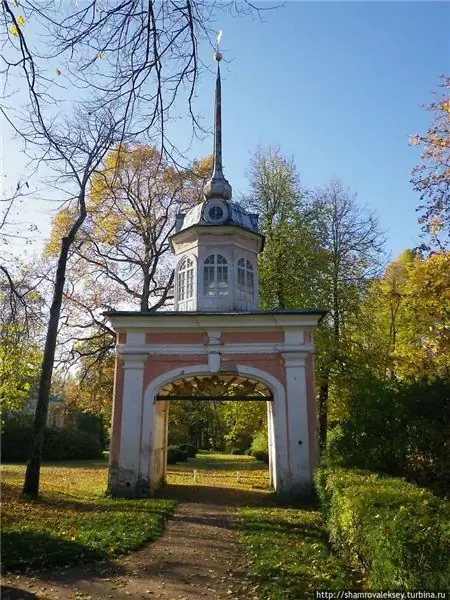
The honorary gate was originally supposed to become the entrance to the fortress of St. Peter. Then, in connection with its restructuring in Petershtadt, hence, the expansion of the fortress, they became the inner gateway to the Arsenal yard. Now the gate is in the scaffolding, they are being restored, so I had to be content with a photo from the Internet.
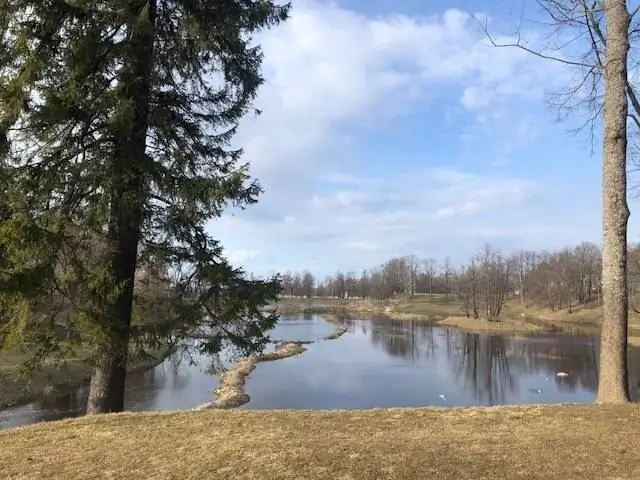
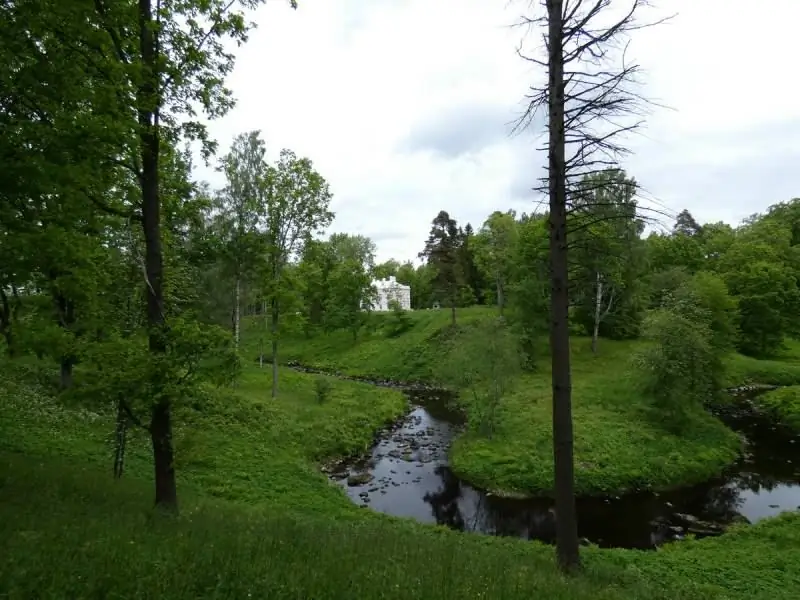
And this is how the view of the palace of Peter III looks like from the other bank of the Karasta. Agree, although the fortress is no longer there, it is very beautiful! It is really very pleasant to walk here, at least alone, in your own thoughts, even in a large company. The only caveat is that you cannot walk on the lawns, the guards are vigilantly watching this.
What can I say in conclusion … It is only worth saying that you need to take good care of what surrounds us! We often do not appreciate those things, and even those people who are nearby. For example, Peter III did not understand Russia, spending time with the Holsteins, while the Russian guard did not forgive him for such an attitude towards her. As a result, the unfortunate king lost everything he had, including his own life. This is his example. And here's another. In the 90s, many of us got rid of old Soviet things - furniture, turntables, etc. But now we regret that we threw away or sold these things, because they would look great in a modern setting, like rarities! For example, the author personally has one friend, a very decent person who collects Soviet furniture. Takes it, restores it, puts it in the office - it looks subtle and beautiful. Is it bad?
And in the case of Petershtadt, something similar also took place. Unwittingly, we lost the fortress, built according to all the rules of military science of the 18th century. This overgrown building might have seemed stupidity fifty or a hundred years ago, but now, with a "properly organized business", there would be historical reconstructions - even the Seven Years War, even the Pugachev uprisings, and joyful children and their equally happy dads would climb the ramparts. But a person is "strong in hindsight" that having - he does not keep, having lost - cries. A pity, a pity!
But if you ever find yourself in Oranienbaum, go to its southeastern part. I think that there, in Petershtadt, it will be possible to remember that once upon a time the thunder of drums was heard here, the banners rustled, the shouts of commands were heard, and hundreds of soldiers marched in a solemn march. And it is wonderful to remember this, because this is our story, no matter how intricate and contradictory it may sometimes be …






